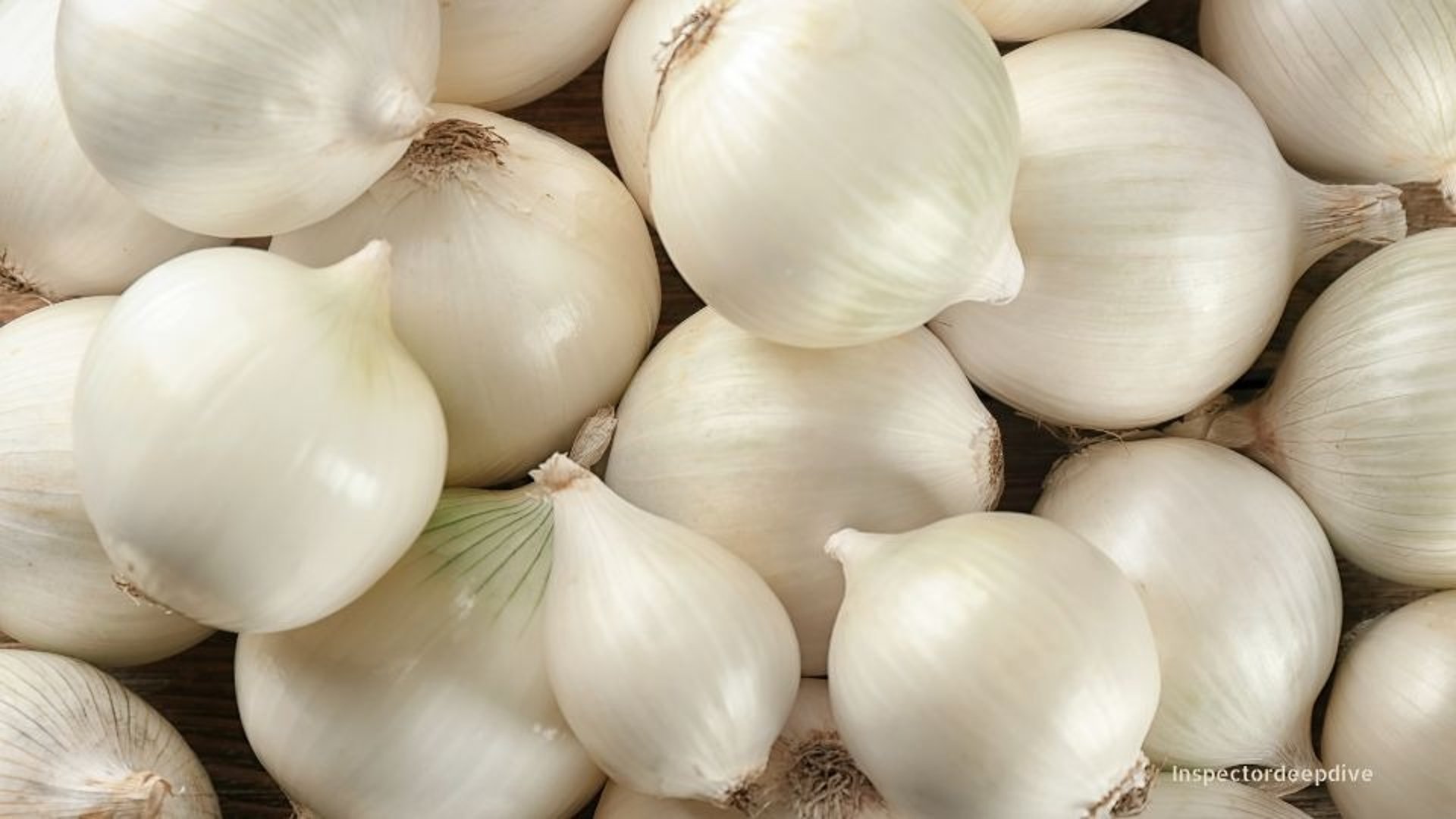
White Onions: A Scientific Look at Nutrition, Composition, and Context.

White Onions: A Scientific Look at Nutrition, Composition, and Context
Scientific name: Allium cepa
Family: Amaryllidaceae
What are White Onions
White onions are a widely consumed variety of onion, recognized by their smooth, white skin and sharp, pungent flavor that mellows when cooked. They are a staple in many global cuisines, prized for their versatility in both raw and cooked dishes. Compared to red onions, white onions have a crisper texture and a slightly more pungent taste, making them ideal for salsas, salads, and a variety of cooked recipes.
Origin and Varieties
White onions belong to the species Allium cepa, sharing the same botanical classification as red and yellow onions. They have been cultivated for centuries and are grown worldwide. Their distinct white color and flavor profile set them apart, and they are often preferred in dishes where a sharper onion flavor is desired without the sweetness of other varieties.
Seasonality & Availability
White onions are available year-round due to extensive cultivation in diverse climates. Their peak season typically falls in late spring through early fall, when they are freshest and most flavorful. They are commonly found fresh, dried, and sometimes pickled in markets globally.
Benefits
Rich in Antioxidants: Contains flavonoids such as quercetin and kaempferol, which provide antioxidant and anti-inflammatory effects.
Supports Heart Health: May help reduce blood pressure and cholesterol levels, contributing to cardiovascular wellness.
Blood Sugar Regulation: Compounds in white onions may improve insulin sensitivity and aid glucose metabolism.
Immune System Support: Provides vitamin C and other nutrients that bolster immune function.
Digestive Health: Contains prebiotic fibers that nourish beneficial gut bacteria, promoting a healthy microbiome.
Antimicrobial Properties: Sulfur compounds contribute to fighting bacterial and fungal infections.
Nutritional Breakdown (per 100 g raw, approx)
Calories: 40 kcal low in calories, making them a healthy addition to meals.
Water: 89 g high water content aids hydration.
Protein: 1.1 g a modest plant-based protein source.
Total Fat: 0.1 g virtually fat-free.
Carbohydrates: 9.3 g ncludes natural sugars and dietary fiber.
Dietary Fiber: 1.7 g supports digestion and gut health.
Sugars: 4.2 g natural sugars contributing to flavor.
Vitamins
Vitamin C: 7.4 mg antioxidant that supports immune health and iron absorption.
Vitamin B6: 0.12 mg essential for amino acid metabolism and neurotransmitter production.
Folate (B9): 19 µg important for DNA synthesis and red blood cell formation.
Thiamine (B1): 0.046 mg involved in energy metabolism and nerve function.
Riboflavin (B2): 0.027 mg supports cellular energy and antioxidant processes.
Niacin (B3): 0.116 mg aids metabolism and skin health.
Pantothenic Acid (B5): 0.123 mg necessary for hormone production and energy release.
Minerals
Potassium: 146 mg regulates blood pressure, fluid balance, and muscle/nerve function.
Phosphorus: 29 mg vital for bone health and energy storage.
Magnesium: 10 mg involved in hundreds of enzymatic reactions.
Calcium: 23 mg supports bone strength and cellular communication.
Iron: 0.21 mg essential for oxygen transport and energy production.
Sodium: 4 mg naturally low in sodium.
Zinc: 0.17 mg supports immune function and wound healing.
Bioactive Compounds
Quercetin: A powerful antioxidant flavonoid with anti-inflammatory and antihistamine effects, linked to cardiovascular and anti-cancer benefits.
Organosulfur Compounds: Responsible for the pungent aroma and flavor; associated with antimicrobial, anti-cancer, and heart-protective effects.
Fructooligosaccharides (FOS) / Inulin: Prebiotic fibers that promote beneficial gut bacteria and digestive health.
Other Antioxidants: Including vitamin C and various polyphenols that combat oxidative stress.
How They Affect the Body
Antioxidant & Anti-inflammatory: Quercetin and sulfur compounds neutralize free radicals and reduce inflammation.
Cardiovascular Health: May lower blood pressure, reduce cholesterol, and prevent arterial plaque buildup.
Gut Health: Prebiotic fibers support a healthy microbiome and immune function.
Blood Sugar Management: Compounds may improve insulin sensitivity and glucose metabolism.
Risks and Cautions
FODMAPs: High in fructans, which can cause gas and bloating in individuals with Irritable Bowel Syndrome (IBS).
Raw Irritation: Pungent flavor may irritate sensitive mouths or stomachs.
Allergy: Rare onion allergies exist.
Medication Interactions: Large amounts may have mild blood-thinning effects; consult healthcare providers if on anticoagulants.
Storage & Shelf Life
Whole, uncut: Store in a cool, dry, well-ventilated place (avoid refrigeration) for several weeks.
Cut or peeled: Refrigerate in airtight containers; use within 7–10 days.
Cooked: Refrigerate and consume within 3–4 days.
Culinary Tips
Raw Use: Adds sharpness and crunch to salads, salsas, and sandwiches.
Mellowing Flavor: Soak sliced onions in cold water for 15–30 minutes to reduce pungency.
Cooking: Excellent for grilling, roasting, caramelizing, or pickling, which enhances sweetness.
Pairings: Complements cheeses, grilled meats, Mediterranean dishes, and fresh herbs.
Environmental Impact
White onion cultivation generally has a moderate environmental footprint, requiring reasonable water and land resources. Sustainable farming and local sourcing can further reduce environmental impact.
Observed Effects in Research
Findings from peer-reviewed studies 2025:
Antioxidant Activity: Extracts show free radical neutralization in test tubes and animal models. Human relevance remains unclear.
Gut Function: Fiber content may support regular bowel movements and microbial fermentation in the colon.
Blood Sugar Response: Low glycemic load. Some studies suggest mild modulation of glucose metabolism due to quercetin, but no clinical effect established.
Immune Cell Markers: In isolated cells, certain compounds influence cytokine production. No evidence of systemic immune enhancement in humans.
Cardiovascular Indicators: Limited data on lipid profiles; no consistent effect observed in trials.
No study claims white onions prevent, treat, or cure any condition.
Summary
White onions are a nutrient-rich, flavorful vegetable packed with antioxidants, prebiotic fibers, and sulfur compounds. Their consumption supports heart health, digestion, blood sugar regulation, and immune function. Versatile in the kitchen, they enhance a wide variety of dishes with their distinctive pungency and texture.
© 2025 food.InspectorDeepDive.com. All rights reserved. Content may not be copied or republished without permission.
This article is for informational purposes only. InspectorDeepDive.com does not provide medical advice. Always consult a licensed healthcare provider before making dietary or health decisions.
